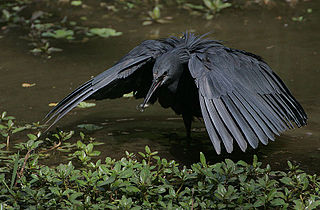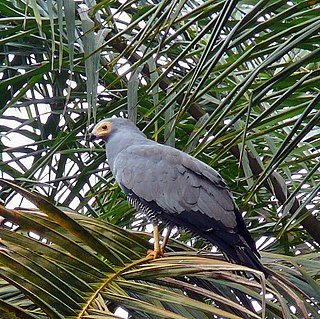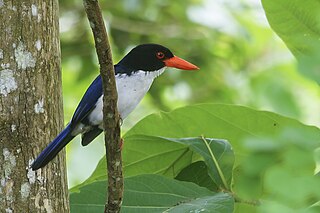
Herring are forage fish, mostly belonging to the family of Clupeidae.

Perodicticinae is a subfamily of the family Lorisidae. It includes five species of African primates as shown under taxonomy below.
Old World warblers are a large group of birds formerly grouped together in the bird family Sylviidae. They are not closely related to the New World warblers. The family held over 400 species in over 70 genera, and were the source of much taxonomic confusion. Two families were split out initially, the cisticolas into Cisticolidae and the kinglets into Regulidae. In the past ten years they have been the subject of much research and many species are now placed into other families, including the Acrocephalidae, Cettiidae, Phylloscopidae, and Megaluridae. In addition some species have been moved into existing families or have not yet had their placement fully resolved. A smaller number of warblers, together with some babblers formerly placed in the family Timaliidae and the parrotbills, are retained in a much smaller family Sylviidae.

Sardine and pilchard are common names for various species of small, oily forage fish in the herring family Clupeidae. The term 'sardine' was first used in English during the early 15th century; a somewhat dubious folk etymology says it comes from the Italian island of Sardinia, around which sardines were once supposedly abundant.

Gadus is a genus of demersal fish in the family Gadidae, commonly known as cod, although there are additional cod species in other genera. The best known member of the genus is the Atlantic cod.

The black heron, also known as the black egret, is an African heron. It is well known for its habit of using its wings to form a canopy when fishing.

The harlequin quail is a species of bird in the family Phasianidae. It occurs in sub-Saharan Africa and in the Arabian Peninsula. The species is named after the collector, Adulphe Delegorgue.

The African yellow warbler, also known as Natal yellow warbler, dark-capped yellow warbler or yellow flycatcher-warbler, is a species of Acrocephalidae warblers; formerly, these were placed in the paraphyletic "Old World warblers".

Polyboroides is a genus of bird of prey in the family Accipitridae. This genus has two recognized species found in Sub-Saharan Africa and Madagascar. The two species are allopatric and restricted to the Afrotropical realm. They are generally known as harrier-hawks.

The spotted greenbul or spotted bulbul, is a species of songbird in the bulbul family, Pycnonotidae. It is classified in the monotypic genus Ixonotus. It is widely spread throughout the African tropical rainforest, from Sierra Leone and Guinea to Ghana; southern Nigeria to Uganda, northern Tanzania, eastern and central Democratic Republic of the Congo and extreme north-western Angola. Its natural habitats are subtropical or tropical dry forest, subtropical or tropical moist lowland forest, and moist savanna.

The white-rumped kingfisher or glittering kingfisher is a species of bird in the family Alcedinidae. It is monotypic within the genus Caridonax. It is endemic to Indonesia, where its natural habitats are subtropical or tropical moist lowland forest and subtropical or tropical moist montane forest.
The bob-tailed weaver is a species of bird in the family Ploceidae. It is monotypic within the genus Brachycope. It is found in Cameroon, Central African Republic, Republic of the Congo, and Democratic Republic of the Congo.

Dorst's cisticola, also known as the plaintive cisticola, is a bird in the family Cisticolidae. It occurs in West Africa and south of Lake Chad.

Pycnopygius is a genus of bird in the Meliphagidae, or honeyeater, family. Established by Tommaso Salvadori in 1880, it contains the following species:

The northern yellow white-eye, formerly the African yellow white-eye, is a species of bird in the family Zosteropidae. It is found across sub-Saharan Africa, from Senegal in the west across to southern Sudan in the east and south to northern Angola.

Heuglin's wheatear is a small passerine bird in the wheatear genus Oenanthe.

Carp's tit or Carp's black tit, is a species of bird in the family Paridae. Some authors consider it a subspecies of the black tit. It is found throughout the Namibian savanna woodlands and the southern Angolan mopane woodlands.

An anchovy is a small, common forage fish of the family Engraulidae. Most species are found in marine waters, but several will enter brackish water, and some in South America are restricted to fresh water.

The African warblers are a newly erected family Macrosphenidae, of African songbirds. Most of the species were formerly placed in the Old World warbler family Sylviidae, although one species, the rockrunner, was placed in the babbler family, Timaliidae. A series of molecular studies of the Old World warblers and other bird families in the superfamily Sylvioidea found that the African warblers were not part of Sylviidae but were instead an early (basal) offshoot of the entire clade Sylvioidea. Some taxonomic authorities place the entire family Hyliidae here.




















